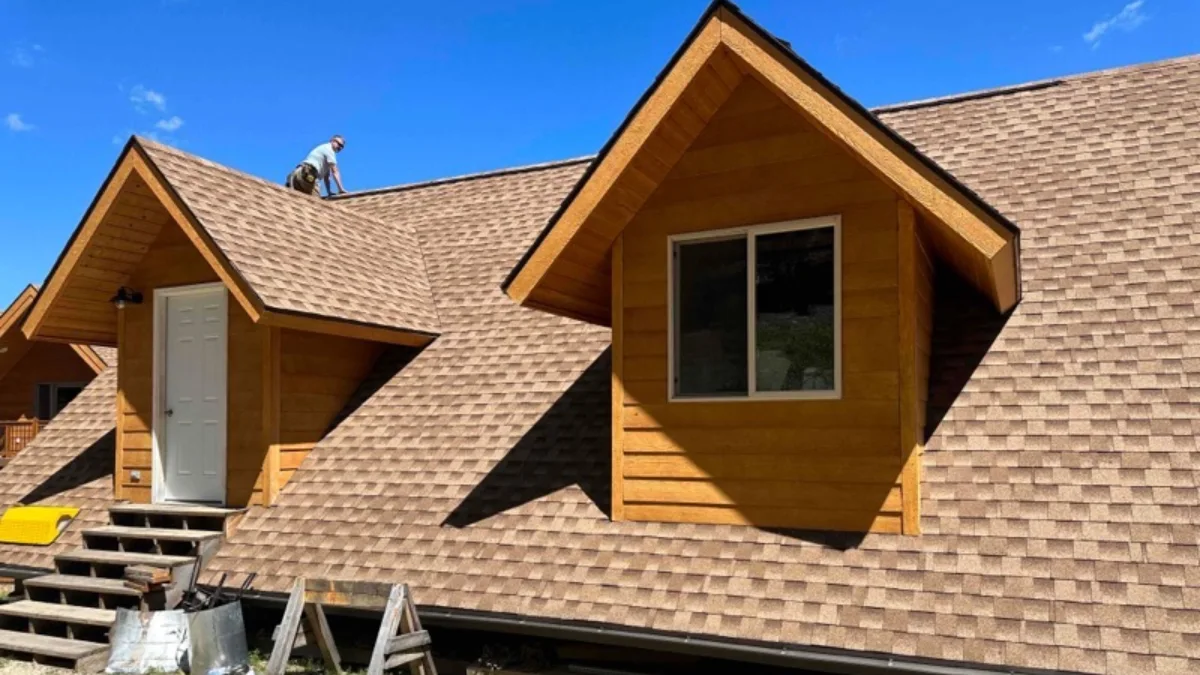Your roof is your home’s first line of defense against the elements, but it’s easy to overlook its condition. Recognizing the signs your old roof needs repair can save you from costly damage and extensive renovations down the line. Homeowners often wonder how to know if they need a new roof or when to replace their existing one. Roof leaks can lead to costly damage if not addressed promptly. Understanding these warning signs is crucial for maintaining your home’s integrity and value.
In this article, we’ll explore 4 signs your roof needs repair, helping you identify potential issues before they escalate. From visible damage observable from the ground to interior red flags like ceiling spots, we’ll cover key indicators that signal it’s time for roof maintenance or replacement. We’ll also discuss gutter problems and the impact of severe weather on your roofing materials. By the end, you’ll be better equipped to spot signs of a bad roof and know when to call a roofing contractor for a professional inspection.
4 Signs Your Roof Needs Repair
Visible Roof Damage: What to Look for From the Ground
Homeowners can spot potential roof issues without climbing onto their roofs. By conducting visual roof inspection from the ground using binoculars, they can identify signs that indicate the need for roof repair or replacement. Here are key areas to focus on:
Spotting missing shingles or damaged shingles
Missing shingles leave noticeable gaps in the roof’s cover, similar to a missing puzzle piece. These gaps allow moisture and pests to enter the home. Damaged shingles may appear bruised, blistered, cracked, or curled. Cracked shingles are a sign that the roof may need replacement. Bruised shingles often show darker coloration with round, concave dents. Blistered shingles have small, concentrated areas where granules are missing, exposing the underlayment. Curled or cupped shingles have raised edges or concave centers, which can collect water and lead to leaks.
Identifying areas of discoloration
Discoloration on the roof can indicate various issues with the roof covering. Dark greenish-black streaks, especially on the north-facing side, may signal algae growth. Rust appears as brown or red stains, particularly near metal fixtures or flashing. As asphalt shingles age, they may lose their black pigment, resulting in streaks that resemble algae growth. Brown stains near trees could be caused by debris or animal droppings. Some roofing materials may experience defects after installation, causing black stains that spread across the roof.
Recognizing changes in the roof line
A sagging roof is a clear sign of structural issues, often caused by severe water damage or broken rafters. This problem requires immediate attention from a roofing professional. Additionally, uneven areas or unusual dips and high spots may indicate improper underlayment installation, which can lead to further complications if left unaddressed.
Interior Red Flags: Leaking Roof, Ceiling Spots, and Peeling Paint
Interpreting water stains on ceilings
Water stains on ceilings are more than just unsightly marks; they’re warning signs of potential damage in a home, often indicating a leaking roof. These stains often appear as large, amorphous shapes with darker coloration, sometimes even appearing wet or damp. They can indicate various issues, such as leaky roofs, malfunctioning HVAC systems, or high moisture levels.
The pattern of the stain can provide clues about its origin. Circular patterns usually suggest drips from a leaking roof or faulty plumbing fixtures, while larger blotches might indicate more serious problems with roofing material or insulation. It’s crucial to address these stains promptly to prevent further damage.
Understanding the causes of peeling interior paint
Peeling paint is another red flag that homeowners should not ignore. It occurs when paint begins to separate from the surface, often due to environmental factors or improper application. High humidity in poorly ventilated areas can cause moisture build-up, leading to paint blistering and peeling. This is particularly common in bathrooms, kitchens, and laundry rooms.
Extreme temperatures, both hot and cold, can also weaken paint’s adhesive properties. In dry environments, paint may fail to form strong bonds with the surface, causing it to peel over time. Additionally, painting over dirty or greasy surfaces can result in poor adhesion and eventual peeling.
Importance of prompt investigation
Prompt investigation of ceiling spots and peeling paint is crucial to prevent further damage to your home. Where damp rafters are found, it can indicate potential roof leaks and overall roof damage. These issues often indicate underlying problems that, if left unaddressed, can lead to more severe and costly damage. Regular inspections of both the interior and exterior of your property can help identify potential sources of water leaks or moisture problems early on.
When dealing with water stains or peeling paint, it’s essential to determine the root cause. This may involve checking for roof leaks, inspecting plumbing fixtures, or assessing ventilation in high-moisture areas. In many cases, professional help may be necessary to accurately diagnose and resolve the issue, ensuring the long-term integrity and aesthetic appeal of your home.
Gutter Issues: Overflowing and Sagging Signs
How gutter problems relate to roof health
Gutters play a crucial role in protecting a home’s roof and overall structure. When gutters fail to function properly, it can lead to serious issues. Clogged or sagging gutters prevent water from draining effectively, causing it to overflow and potentially seep into the roof surface. This can result in water damage, rot, and weakening of the roof structure. Over time, trapped water can penetrate roofing materials, compromising the roof’s waterproofing properties and leading to leaks.
Identifying gutter damage and blockages
Homeowners should be aware of signs indicating gutter problems. Overflowing water during rainfall is a clear indicator of blockage or misalignment. Sagging gutters that pull away from the roofline suggest structural issues, often caused by debris accumulation or improper installation. Regularly inspecting gutters for debris build-up, such as leaves and twigs, is essential to prevent clogs and ensure proper water flow.
Impact on foundation and siding
Faulty gutters can have far-reaching consequences beyond the roof. When gutters fail to divert water away from the house, it can pool around the foundation, leading to moisture-related problems. This excess water can create pressure on the home’s lower walls and basement, potentially causing cracks or inward pushing. Additionally, water spillage from damaged gutters can saturate the soil around the house, leading to erosion and foundation settling. This may result in uneven floors or cracks in walls and chimneys. The constant exposure to water can also damage the home’s siding, promoting mold growth and compromising its structural integrity.
Weather Impact: Assessing Damage After Storms
Storms can have a significant impact on roofs, causing various types of damage that may not be immediately visible. Homeowners should be aware of common storm-related issues and the importance of timely inspections to prevent further damage.
Common types of storm damage to roofs
Storms can cause several types of roof damage. Storms can also lead to granule loss on an asphalt roof, which is a critical sign indicating it’s time for a roof replacement.
- Wind damage: Tears, cracks, curled corners, or missing shingles. The typical lifespan of asphalt shingle roofs is approximately 20 to 30 years, and it’s important to inspect them after storms.
- Hail damage: Small dark spots on asphalt shingles, cracks on cedar shake roofs
- Tree damage: Fallen branches or fruit causing noticeable impact
- Water damage: Leaks, moisture build-up, and potential mold growth
Importance of post-storm roof inspections
Conducting a roof inspection soon after a storm is crucial for several reasons:
- Early identification of damage prevents the escalation of problems
- Allows for timely repairs, saving money on future costs
- Helps maintain the roof’s structural integrity and efficiency
- Provides necessary documentation for insurance claims
Inspecting the roof’s shingles for signs of damage, such as cracks or curling, is particularly important after severe weather events.
Must Read: Hail Damage Roof Inspections | A Comprehensive Guide
When to call a professional for roof replacement assessment
While homeowners can perform initial visual inspections, certain situations require professional expertise:
- Visible structural damage, such as holes or collapse
- Signs of sagging or bending, indicating underlying issues
- Extensive shingle damage or missing sections
- Water stains on ceilings or walls
- Peeling paint near the roofline
A professional roofing contractor can provide a thorough assessment and recommend appropriate repairs or replacements to ensure the roof’s long-term health and functionality.
Free Roof Inspections. Fast. Reliable.
Is your roof ready to weather the storm? Dont risk property damage. Our free roof inspections provide expert analysis to identify potential issues before they become costly problems.
Conclusion
To wrap up, maintaining a healthy roof is crucial for protecting your home and avoiding costly repairs. By keeping an eye out for visible damage, interior red flags, gutter issues, and storm-related problems, homeowners can catch potential issues early. Regular roof inspections and prompt action when signs of trouble appear are key to extending the life of your roof and safeguarding your home’s structure.
Remember, while some roofing issues can be spotted from the ground, others may require a professional assessment. If you notice any of the signs discussed in this article, don’t hesitate to call in an expert. Taking care of your roof now can save you time, money, and stress in the long run. A well-maintained roof not only protects your home but also enhances its value and curb appeal.
FAQs
What are the primary causes of roof damage?
Understanding the most common causes of roof damage can help in prevention. These include aging shingles, lack of regular maintenance, the impact of water combined with cold temperatures, wind and storms, extreme heat, improper installation, and walking on the roof.
How can you identify when a roof needs to be replaced?
There are several signs that indicate the need for a roof replacement, including water leaks which should be addressed immediately, curled, cracked, or ripped shingles, the presence of moss or algae, missing granules from shingles, rusted gutters or flashing, a wavy roof appearance, and exposed, rusty nails.
What extent of damage necessitates a roof replacement?
Roof replacement is typically considered based on the extent of damage observed in “test squares” which are usually 10 x 10 feet sections on each slope of the roof. The required amount of damage in these squares varies by company but generally ranges from 6 to 12 areas of damage per square. Regular roof inspections can help catch these issues early, potentially saving homeowners thousands of dollars in roofing repair costs.
What indications suggest that a roof is in good condition?
A roof in good condition will appear relatively straight without any stains. The shingles should be intact without any cracks, dents, or missing pieces. Additionally, there should be minimal build-up in the gutters and no algae present on the roof. Addressing issues early is crucial to minimize repair costs and ensure the longevity of the roof.



